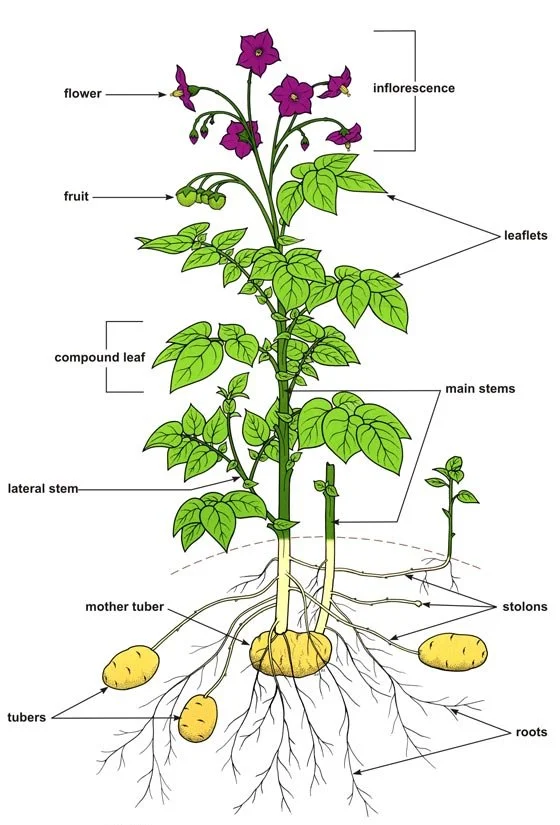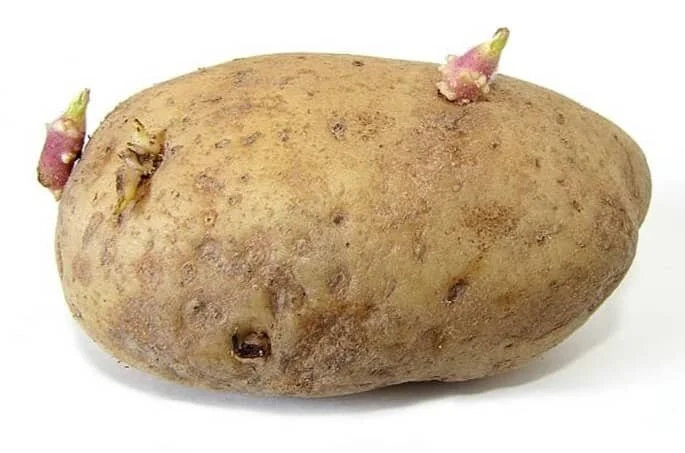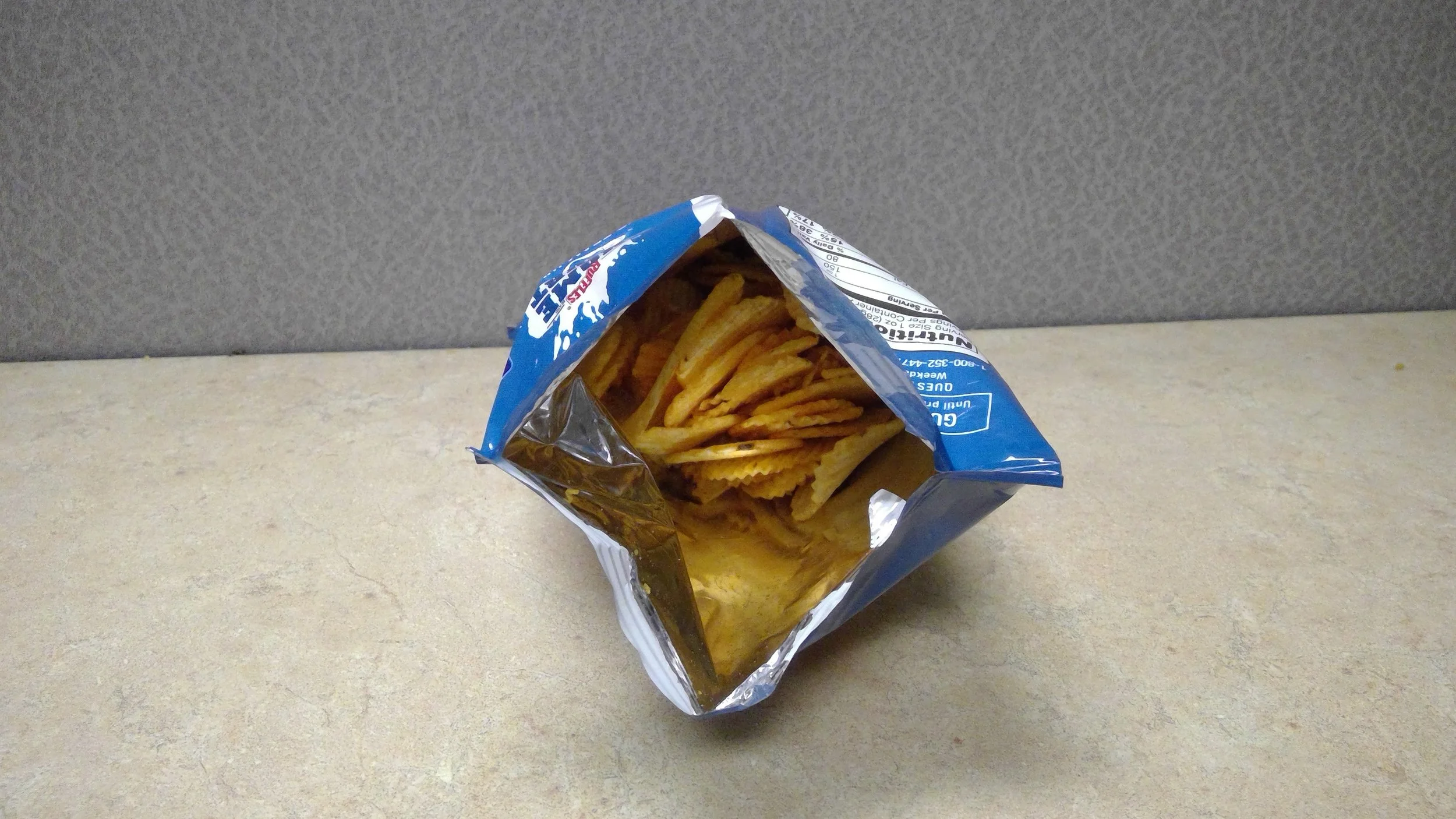Why do potatoes sprout?
The short answer
Potatoes sprout from small stem nodes called eyes when they are kept in warm, humid, and light conditions, using stored starch to fuel asexual reproduction and grow new plants.
The long answer
If you leave a bag of potatoes sitting around for a long time (okay, a really long time), you might end up with something that looks like this:
These potatoes may have been forgotten, but they never forgot their mission to sprout. 🫡
Source: Reddit
These potatoes have "grown eyes" and sprouted. What in the world is going on?
What is a potato?
A potato is the underground stem tuber of a potato plant. While commonly called a root vegetable, it's technically part of the stem.
While roots suck up nutrients from the ground, the potato stem tuber stores those nutrients for future use, mainly in the form of starch. The potato also provides a way for the plant to reproduce asexually.
"CIP-Afiche-papa-ingles" by International Potato Center (CIP) is licensed under CC BY 4.0.
A potato plant grows from a potato, called the mother tuber (aww ☺️). Roots shoot down to draw nutrients from the soil and stems start to sprout into leaves above ground.
As a potato plant grows, its photosynthesizing leaves send sucrose down the stems to the tubers, where the sugar is converted into starch. The stems thicken to form more tubers to store more energy and produce more future potato plants.
When the potato plant's leaves and stems die at the end of the season, the new tubers detach, hunker down for the winter, and then regrow into a new potato plant in the spring.
Why do potatoes sprout?
Potatoes start sprouting when they're stored in a warm, humid, and well-lit environment for a long time
As the potato grows stems from the "eyes," it draws starch from the mother tuber, which is why it begins to feel soft and withered. These sprouts are the stems, which is why farmers plant them facing up. The potato is already a source of nutrients, so there's a lower priority to grow roots than to grow leaves.
"Potato with sprouts" by ZooFari is part of the public domain
Each "eye" of a potato is a node capable of growing into a green, leafy shoot. An interesting fact about potatoes is that the eyes are arranged in a spiral pattern.
This video does a great job showing the spiral pattern of potato eyes.
The angle formed by connecting one eye to the next via the center of potato is about 137.5°, or the "golden angle." This spiral pattern is common in nature, especially in how leaves are arranged on stems. It is the most efficient way to grow leaves so they all can soak up sunlight without casting a shadow on one another. Pretty cool, right?
Do potatoes have seeds?
Yes, while potatoes mainly reproduce asexually from tubers, they also flower and produce seed-filled fruits. Potato plants produce small green fruits filled with hundreds of seeds, bearing a striking resemblance to cherry tomatoes.
But don't eat these tomato-looking potatoes. The fruits contain solanine, which can cause headaches, cramps, and, in some cases, death.
Forbidden potato tomato.
"Solanum tuberosum 004" by H. Zell is licensed under CC BY-SA 3.0.
When you grow a potato from a potato, it is an exact clone of the original plant since there was no sexual reproduction. But when you grow a potato from a seed, it will have different characteristics from the parent plant.
🧠 Bonus brain points
Why does a bag of potato chips briefly smell like a fart when you open it?
When potato chips are packaged, the bags are filled with nitrogen gas to lower the oxygen level to 3% or less (for context, regular air has 21% oxygen and 78% nitrogen).
This process extends the chips' shelf life. While oxygen causes the fat in the chips to oxidize and taste off, nitrogen doesn't cause any chemical reactions that affect flavor.
"Opened bag of Ruffles All Dressed potato chips" by Ser Amantio di Nicolao is licensed under CC BY-SA 4.0.
But volatile compounds are created during the chips' cooking process, and despite the pump of nitrogen, the lingering 3% oxygen can still oxidize the oils and seasonings, especially if they've sat around for a while.
So when you pop open a bag of chips, you get a whiff of those volatile compounds, especially the stinky sulfur-based ones, and the chips smell like toots for a brief moment.
Curious about how the world works?
Today You Should Know is a free, weekly email newsletter designed to help you learn something new every Friday.
Subscribe today 👇
Check out some other curious questions:
Sources
American Farm Bureau Foundation for Agriculture. (2023, July 6). How Do Potatoes Grow?. American Farm Bureau Foundation for Agriculture. https://www.agfoundation.org/news/how-do-potatoes-grow
Go Figure Math. (n.d.). The Golden Angle. Go Figure Math. https://gofiguremath.org/natures-favorite-math/the-golden-ratio/the-golden-angle/
Grant, A. (2021, May 3). What Is True Potato Seed: Learn About Potato Seed Growing. Gardening Know How. https://www.gardeningknowhow.com/edible/vegetables/potato/true-potato-seed-growing.htm
International Potato Center. (2017, September 21). How Potato Grows. International Potato Center. https://cipotato.org/potato/how-potato-grows/
Kurczodyna, J. (2025, January 26). Planting Potatoes With Long Sprouts – Everything You Need To Know. From Scratch Farmstead. https://fromscratchfarmstead.com/planting-potatoes-with-long-sprouts/
McGorrin, R. J. (2011). The significance of volatile sulfur compounds in food flavors. ACS Symposium Series, 3–31. https://doi.org/10.1021/bk-2011-1068.ch001
Preston, K. A. (2016, February 6). Botany Lab of the Month (Oscars edition): potatoes. The Botanist in the Kitchen. https://botanistinthekitchen.blog/2016/01/23/botany-lab-of-the-month-oscars-edition-potatoes/
Schneider, M. (2016, September). The Atmosphere Inside a Bag of Potato Chips. Atmospheric Resource Board | North Dakota State Water Commission. https://www.swc.nd.gov/arb/news/atmospheric_reservoir/pdfs/2016_09%20-%20The%20Atmosphere%20Inside%20a%20Bag%20of%20Potato%20Chips.pdf
Singh, M. (2014, July 24). The Weird, Underappreciated World Of Plastic Packaging. NPR. https://www.npr.org/sections/thesalt/2014/07/24/334617901/the-weird-underappreciated-world-of-plastic-packaging
Stovall, E. (n.d.). Why Do Potatoes Sprout?. Mississippi State University Extension Service. https://extension.msstate.edu/blogs/extension-for-real-life/why-do-potatoes-sprout
Washington State Potato Commission. (n.d.). Potato Plant. Washington State Potato Commission. https://www.potatoes.com/about-us/our-farms/how-we-grow









It’s like an American accent but with calendars.